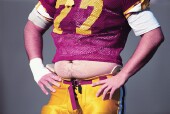
THURSDAY, Aug. 19 (HealthDay News) — Heat-related sicknesses sideline American high school athletes for more than 9,000 days a year, a new study finds.
The majority of such illnesses (70.7 percent) occur among football players, according to U.S. Centers for Disease Control and Prevention researchers who analyzed 2005-09 data from the National High School Sports-Related Injury Surveillance Study.
About two-thirds of heat-related illnesses occur during August and most happen during practices, not games. Overweight athletes are most likely to be affected.
For the study, the researchers examined nine sports and estimated national numbers based on a sample of 100 high schools. The sports included boys’ football, wrestling, soccer, baseball, and basketball and girls’ volleyball, soccer, basketball and softball. The study looked at the incidence of “time-loss heat illness,” defined as illness where a player needed at least one day to recover and missed time on the game field.
Heat-related illnesses included heat cramps, heat exhaustion, and heat stroke.
Between 2005-09, the 100 schools included in the study reported a total of 118 heat illnesses among athletes, which works out to a rate of 1.6 per 100,000 athlete exposures and an average of 29.5 time-loss heat illnesses per school year. Based on those figures, the researchers calculated an average annual estimate of 9,237 heat illnesses nationwide.
The highest rate of time-loss heat illness was among football players — 4.5 per 100,000 athlete exposures. That rate is 10 times higher than the average rate (0.4 per 100,000) for the eight other sports included in the study.
No heat illness-related deaths were reported by any of the schools in the study, which appears in this week’s Morbidity and Mortality Weekly Report, published by the CDC.
However, heat stroke has claimed the lives of 31 U.S. high school football players since 1995, according to the National Center for Catastrophic Sports Injury Research.
“One death due to heat-related illness is too many,” Michael McGeehin, director of the CDC’s Division of Environmental Hazards and Health Effects, said in an agency news release. “Heat-related illness is preventable; the more we know about how and when it happens, the better we can prepare people who may be most at risk.”
Athletes, coaches, trainers and parents should know the signs and symptoms of heat-related illness. They should also know about the importance of proper hydration before, during and after strenuous physical activity, the CDC said.
To help student-athletes’ bodies get used to hot weather, coaches should gradually increase practice duration and intensity over 14 days. Athletes need to drink plenty of water and sports beverages to replace the water and salt they lose through sweating. They also need to take breaks when needed, the CDC said.
More information
The American Academy of Family Physicians has more about heat exhaustion and heat stroke.

